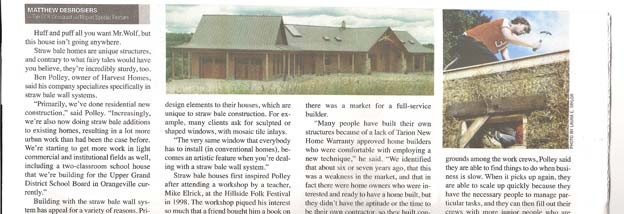Harvest Homes meets niche market demands – Ontario Construction Report
Huff and puff all you want Mr. Wolf, but this house isn’t going anywhere.
Straw bale homes are unique structures, and contrary to what fairy tales would have you believe, they’re incredibly sturdy, too.
Ben Polley, owner of Harvest Homes, said his company specializes specifically in straw-bale wall systems.
“Primarily, we’ve done residential new construction,” said Polley. “Increasingly, we’re also now doing straw bale additions to existing homes, resulting in a lot more urban work than had been the case before. We’re starting to get more work in light commercial and institutional fields as well, including a two-classroom school house that we’re building for the Upper Grand District School Board in Orangeville currently.”
Building with the straw bale wall system has appeal for a variety of reasons. Primarily, the system is very energy-efficient due to a high level of insulation provided by the bales. Also, straw bale walls are nearly fireproof, have four times the lateral strength of a typical 2×6 frame wall, and 10 times the vertical load capacity.
Straw bale systems have a striking aesthetic quality, as well. The combination of the thick walls and the plaster finish create the look of an old, stone structure, Polley said.
“That’s one of the reasons why recently we found such interest in straw bale additions against existing older conventional homes,” he said. “It works well as a building finish. It’s complementary to things like traditional brick, stone or log. It is a wall system and it is a finish that doesn’t give away exactly what it is made of, but it has enough features, whether it’s the texture of the plaster or the depth of the wall, that allows it to blond well with a traditional wall system.
Apart from strictly building these systems, Harvest Homes also offers various design elements to their houses, which are unique to straw bale construction. For example, many clients ask for sculpted or shaped windows, with mosaic tile inlays.
“The very same window that everybody has to install (in conventional homes), becomes an artistic feature when you’re dealing with a straw bale wall system.”
Straw bale houses first inspired Polley after attending a workshop by a teacher, Mike Elrick, at the Hillside Folk Festival in 1998. The workshop piqued his interest so much that a friend bought him a book on the subject. Before Polley was finished reading, he was inspired to quit his job and pursue straw bale construction.
“I was intending to become an owner/builder, and that’s how it started,” he said. “What I found was right away, when I started connecting with other people with similar inclinations, that there was a market already for anybody that knew anything about straw bale building.”
Polley, whose background is business and geography, began surrounding himself with people from the construction industry.
“They taught me what I needed to know about conventional building, and I learned and shared what I was beginning to learn about alternative construction.”
He started Harvest Homes in 2000, and as the business grew, Polley identified an untapped area of the market that would take the company to new heights.
Up until a few years ago, Harvest Homes, like most straw bale builders, specialized in helping owner/builders to construct their homes. However, he realized there was a market for a full-service builder.
“Many people have built their own structures because of a lack of Tarion New Home Warranty approved home builders who were comfortable with employing a new technique,” he said. “We identified that about six or seven years ago, that this was a weakness in the market, and that in fact there were home owners who were interested and ready to have a home built, but they didn’t have I he aptitude or the time to be their own contractor, so they built conventionally for lack of builder options.”
In 2006, Harvest Homes launched a sister business, Evolve Builders Group Inc to become a Tarion certified home builder, allowing them to tap into that area of the market. They are, essentially, the only Tarion approved straw bale home builder in Ontario.
“In my opinion, the market exists for several businesses like ours across the province,” lie said.
Harvest Homes is a $1.5 million per year company, with 10 full-time employees, and three work crews. Every year, from 2000 to 2006, their sales have doubled. Only now are they starting to stabilize.
“For a business our size, we’re a lot more highly skilled than other businesses,” he said. “We tend to attract a lot of experienced and highly skilled existing tradespeople who are tired of doing the same old thing, and are happy to come work among our work crews, Polley said they are able to find things to do when business is slow. When it picks up again, they are able to scale up quickly because they have the necessary people to manage particular tasks, and they can then fill out their crews with more junior people who are trained to manage larger roles later on.
“What that’s allowed us lo do is not only adjust quickly lo changes in volume of work, but it’s also meant that we’ve been able to grow the business rapidly.”
Harvest Homes is spreading its geographical market by finding partner businesses across the province, and forming joint ventures with them The partnership allows them lo share their experience and system details with these companies.
“We benefit from the fact that they are conscientious and local, and already have established contacts in the industry,” he said.
Currently, the company has build crews in Guelph, Bruce-Grey, and Orillia areas, together servicing much of southern Ontario and Muskoka.
“Our expectation is that we’re going to start spreading ourselves more broadly into the Ontario market,” said Policy. “I haven’t seen a lot of evidence that anybody is moving ito fill this void.”

